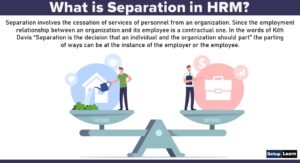Motivating employees to work according to the wishes of the organisation, is a very complex procedure. There are many variables which have an influence on the way in which they work. Over a period of time, many theories of motivating employees have been proposed by behavioural scientists. These theories are termed theories of motivation. The most important theories are content theories and process theories.
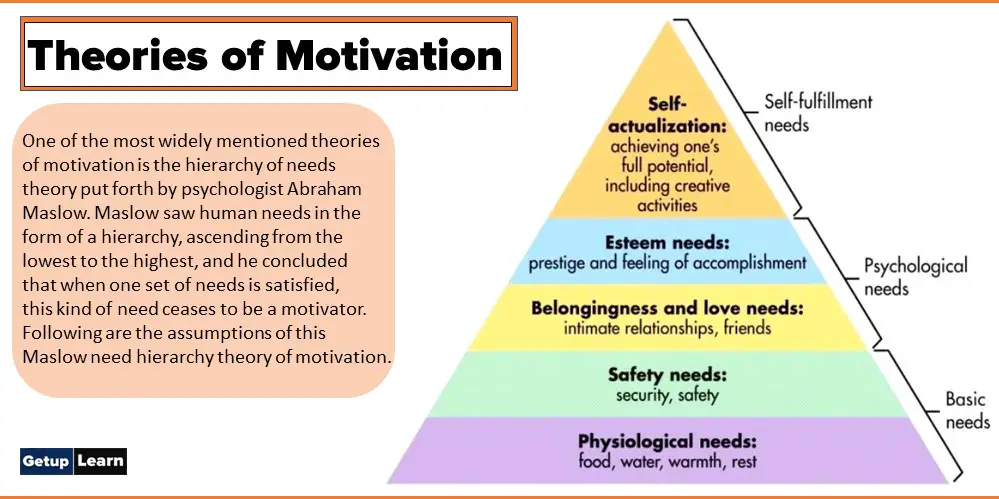
Table of Contents
- 1 Theories of Motivation
- 2 Maslow Need Hierarchy Theory of Motivation
- 3 Herzberg Two Factor Theory of Motivation
- 4 McClelland Need for Achievement Theory
- 5 McGregor Theory X and Theory Y
- 6 Clayton Alderfer Erg Theory of Motivation
- 7 Vroom’s Expectancy Theory
- 8 Reinforcement Theory
- 9 Goal Setting Theory of Edwin Locke
- 10 Cognitive Evaluation Theory
- 11 FAQ Related to Theories of Motivation
Theories of Motivation
These theories of motivation determine what motivates people at work these theories identify the needs or drives that people have at work and how they prioritise these theories also throw light on the type of goals and incentives that people strive for in order to satisfy their needs. These are the theories of motivation explained below:
- Maslow Need Hierarchy Theory of Motivation
- Herzberg Two Factor Theory of Motivation
- McClelland Need for Achievement Theory
- McGregor Theory X and Theory Y
- Clayton Alderfer Erg Theory of Motivation
- Vroom’s Expectancy Theory
- Reinforcement Theory
- Goal Setting Theory of Edwin Locke
- Cognitive Evaluation Theory
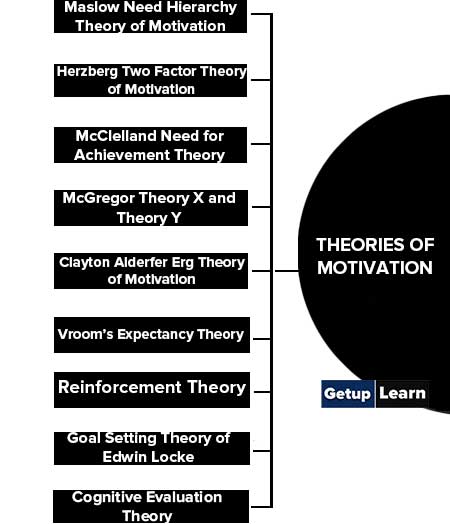
Maslow Need Hierarchy Theory of Motivation
One of the most widely mentioned theories of motivation is the hierarchy of needs theory put forth by psychologist Abraham Maslow. Maslow saw human needs in the form of a hierarchy, ascending from the lowest to the highest, and he concluded that when one set of needs is satisfied, this kind of need ceases to be a motivator. Following are the assumptions of this Maslow need hierarchy theory of motivation:
- People’s behaviour is based on their needs. Satisfaction with such needs influences their behaviour.
- People’s needs are in hierarchical order, starting from basic needs to other higher-level needs.
- A satisfied need can no longer motivate a person; only the next higher level need can motivate him.
- A person moves to the next higher level of the hierarchy only when the lower need is satisfied.
According to him, there seems to be a hierarchy into which human needs are arranged which is as under:
Psychological Needs
These needs are the basic needs of the individual and they have the highest strength. Until they are not satisfied to a reasonable extent, the focus of the individual remains on fulfilling these needs. The satisfaction of these needs is required up to a reasonable level so that the person can operate in an efficient manner.
The majority of a person’s activities will probably be at this level and till these needs are reasonably satisfied, other needs offer very little motivation to the individual. As these needs are concerned with the basic necessities of life, the man first tries to fulfil these needs and then proceeds to fulfil other needs.
Safety Needs
Once the physiological needs are satisfied to a reasonable level, other levels of needs become important. It is not necessary that safety needs become important only other the physiological needs are fully satisfied. The degree of reasonableness also depends on each individual and is subjective.
The safety needs include the need of feeling safe and secure. In an organisation, safety needs hold considerable importance and the organisation can influence these needs in a positive manner through measures such as pension plans, and insurance plans or in a negative manner by arousing fear of being fired, laid off or being demoted.
After the first two needs are satisfied, the Belongingness and love needs / Social needs become important. Since a person is a social being, he feels a need to belong and to be accepted by various groups. When these needs become dominant, a person strives for relations with others.
If the opportunity for association with others is reduced, they may take vigorous action against obstacles. Workers form an informal group environment. Such an environment develops where the work is routine, tedious or oversimplified. These types of needs fulfil the desire of an individual for affiliation.
Esteem Needs
The esteem needs are concerned with self-respect, self-confidence, a feeling of personal worth, feeling of being unique and recognizable. Satisfaction with these needs produces feelings of self-confidence, prestige, power and control.
Self Actualization Needs
These needs are related to the development of one’s potential and the development of the capabilities of an individual which lead people to seek situations that can maximize their potential. This includes both physical achievements as well as social achievements. A person with high intensity of such needs would be restless unless he finds fulfilment in what he does.
This theory assumes that human needs have a hierarchy and the needs follow this hierarchy. It also assumes that once a need is satisfied then only the other needs arise. But it is not so in reality. The hierarchy of each individual may be different and the pattern it follows might also be different as needs are a subjective aspect.
Herzberg Two Factor Theory of Motivation
Frederick Herzberg and his associates conducted research wherein they interviewed 20 engineers and accountants from nine different companies in the Pittsburg area of the U.S.A. These executives were asked to recall specific incidents in their experience which made them feel either exceptionally good or exceptionally bad about their jobs.
On the basis of their study, Herzberg concluded that there are some job conditions which operate primarily to dissatisfy employees while other job conditions operate primarily to build strong motivation and high job satisfaction. He called these factors hygiene factors and motivating factors respectively.
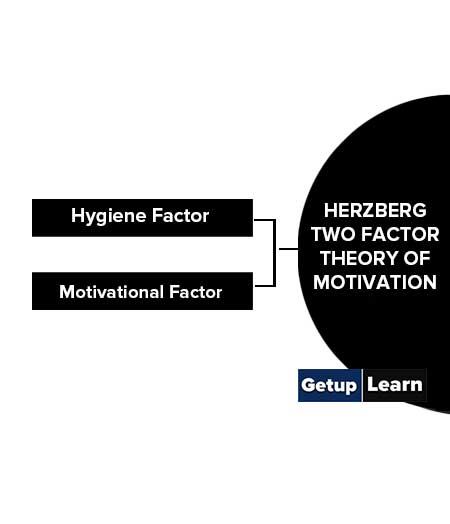
Hygiene Factor
These factors provide no motivation to employees but the absence of these factors serves as dissatisfies. Many of these factors are traditionally perceived by management as motivators but these are really more potent as dissatisfies. These are called ‘Hygiene Factors’ because they support the mental health of employees.
Some of the Hygiene Factors are:
- Wages, salary and other types of employee benefits.
- Company policies and administrative rules that govern the working environment.
- Interpersonal relation with peers, supervisors and subordinates. Cordial relations will prevent frustration and dissatisfaction.
- Working conditions and job security. The job security may be in the form of tenure or it could be supported by a strong union.
Motivational Factor
These factors help to build strong motivation and high job satisfaction. They are also known as satisfiers. These are related to the job content. Their absence or decrease will affect the level of job satisfaction. These factors are achievement, advancement, work itself, the possibility of growth and responsibility.
Some of these Motivational Factors are:
- The Job itself
- Recognition
- Achievement
- Responsibility
- Growth and advancement.
McClelland Need for Achievement Theory
David McClelland has developed a theory on three types of motivating needs:
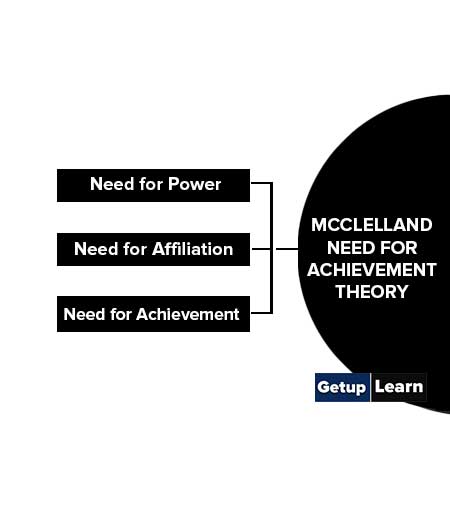
Need for Power
Basically, people with a high need for power are inclined toward influence and control. They like to be at the centre and are good orators. They are demanding in nature, forceful in manners and ambitious in life. They can be motivated to perform if they are given key positions or power positions.
Need for Affiliation
In the second category are the people who are social in nature. They try to affiliate themselves with individuals and groups. They are driven by love and faith. They like to build a friendly environment around themselves. Social recognition and affiliation with others provide them motivation.
Need for Achievement
People in the third area are driven by the challenge of success and the fear of failure. Their need for achievement is moderate and they set for themselves moderately difficult tasks. They are analytical in nature and take calculated risks. Such people are motivated to perform when they see at least some chance of success.
McClelland observed that with the advancement in the hierarchy the need for power and achievement increased rather than Affiliation. He also observed that people who were at the top later ceased to be motivated by these drives.
McGregor Theory X and Theory Y
Different styles of management have a different bearing on the motivation of workers in the organization. The style adopted by a manager in managing his subordinates is basically dependent upon his assumption about human behaviour. Theory X is negative, traditional and autocratic style while Theory Y is positive, participatory and democratic.
Thus, these labels describe contrasting sets of assumptions about human nature. Douglas McGregor has classified the basic assumption regarding human nature into two parts and has designated them as ‘Theory X’, and ‘Theory Y’. Let us understand them in detail:
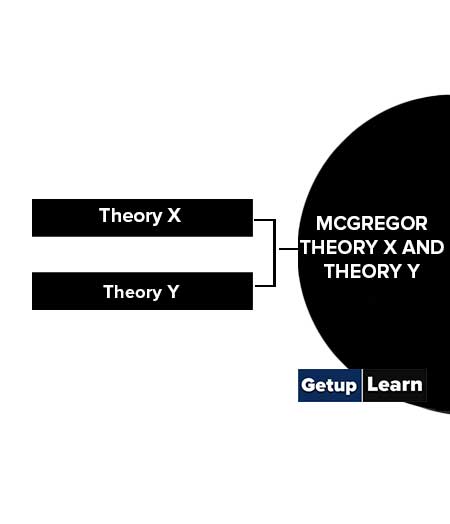
Theory X
Theory X is a traditional theory of human behaviour. The following are the assumptions it makes about the human nature:
- Management is responsible for organizing the elements of productive enterprises such as money, material, equipment and people. This is done in the interest of economic ends.
- To be in conformity with the needs of the organisation, the managers direct the people by directing their efforts, motivating them, controlling them and modifying their behaviour.
- Without the intervention of the management, the people would be passive to the organisational needs. So they have to be persuaded, rewarded, punished and properly directed.
- Any average person dislikes working and would avoid it if he can.
- Any person is devoid of ambition, dislikes responsibility and prefers to be led by someone.
- A person is generally self-centred and is not concerned about organisational needs.
- Employees’ nature is to resist change and they are gullible and not very bright.
Theory Y
Theory Y is the complete opposite of Theory X. The following are the assumptions it makes about the human nature:
- Employees consider being work as natural as play or rest provided the working conditions are favourable.
- An average employee does not inherently dislike work.
- External control and the threat of punishment are not the only means for bringing about efforts toward organizational objectives. Man can exercise self-control and self-direction in the service of objectives to which he is committed.
- Commitment to achieving objectives is directly linked with the rewards which the employee would get on achievement of objectives. People select goals for themselves if they see the possibilities of some kind of reward that may be material or even psychological.
- The average human being, under proper conditions, does not shirk responsibility but learns not only to accept responsibility but also to seek it.
- The employee’s ability to exercise a relatively high degree of imagination, ingenuity and creativity in the solution of organizational problems is widely distributed among all the employees of the organisation.
Clayton Alderfer Erg Theory of Motivation
Alderfer has tried to rebuild their hierarchy of needs of Maslow into another model named ERG i.e. Existence Relatedness Growth. According to him, there are 3 groups of core needs as mentioned above. The existence group is concerned mainly with providing basic material existence. The second group is the individuals who need to maintain an interpersonal relationships with other members of the group. The final group is the intrinsic desire to grow and develop personally. The major conclusions of this theory are:
- In an individual, more than one need may be operative at the same time.
- If a higher need goes unsatisfied then the desire to satisfy a lower need intensifies.
Vroom’s Expectancy Theory
The most widely accepted explanation of motivation has been propounded by Victor Vroom. His theory is commonly known as expectancy theory. The theory argues that the strength of a tendency to act in a specific way depends on the strength of an expectation that the act will be followed by a given outcome and on the attractiveness of that outcome to the individual to make this simple, expectancy theory says that an employee can be motivated to perform better when there is a belief that the better performance will lead to good performance appraisal and that this shall result into the realization of personal goal in form of some reward. Therefore an employee is:
Motivation = Valence x Expectancy.
The theory focuses on three things:
- Efforts and performance relationship
- Performance and reward relationship
- Rewards and personal goal relationship.
Reinforcement Theory
B.F. Skinner, who propounded the reinforcement theory, holds that by designing the environment properly, individuals can be motivated. Instead of considering internal factors like impressions, feelings, attitudes and other cognitive behaviour, individuals are directed by what happens in the environment external to them.
Skinner states that the work environment should be made suitable for the individuals and that punishments actually lead to frustration and demotivation. Hence, the only way to motivate is to keep on making positive changes in the external environment of the organization.
Goal Setting Theory of Edwin Locke
Instead of giving vague tasks to people, specific and pronounced objectives, help in achieving them faster. As the clarity is high, a goal orientation also avoids any misunderstandings in the work of the employees.
The goal-setting theory states that when the goals to be achieved are set at a higher standard in that case employees are motivated to perform better and put in maximum effort. It revolves around the concept of “Self-efficacy” i.e. individual‟s belief that he or she is capable of performing a hard task.
Cognitive Evaluation Theory
As per this theory, a shift from external rewards to internal rewards results in motivation. It believes that even after the stoppage of external stimulus, internal stimulus survives. It relates to the pay structure in the organization. Instead of treating external factors like pay, incentives, promotion etc and internal factors like interests, drives, responsibility etc, separately, they should be treated as contemporary to each other.
The cognition is to be such that even when external motivators are not there the internal motivation continues. However, practically extrinsic rewards are given much more weightage.
What are the 3 major theories of motivation?
According to Maslow’s need hierarchy theory of motivation are: Psychological Needs, Safety Needs, Social Needs, Esteem Needs, Self Actualization Needs etc.
What are the 5 stages of Maslow’s hierarchy of needs?
According to him, there seems to be a hierarchy into which human needs are arranged which is as under:
1. Psychological Needs
2. Safety Needs
3. Social Needs
4. Esteem Needs
5. Self Actualization Needs etc.
What is Herzberg’s two-factor theory summary?
Fredrick Herzberg and associates of Case Western Reserve University conducted research in order to find which factor acts as motivators. They conducted an intensive analysis of the experiences and feelings of 200 engineers and accountants in 9 different companies in the Pittsburg area, USA. During the structural interview, they were asked to describe a few previous job experiences in which they felt exceptionally good or exceptionally bad about their jobs. They were also asked to rate the degree to which their feelings were influenced by each experience.
What is the achievement motivation theory?
David McClelland has developed a theory on three types of motivating needs:
1. Need for Power
2. Need for Affiliation
3. Need for Achievement etc.






